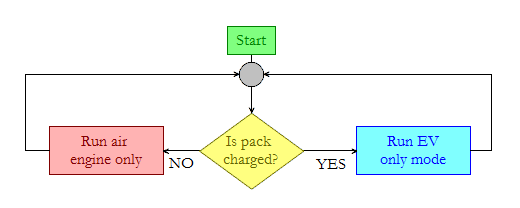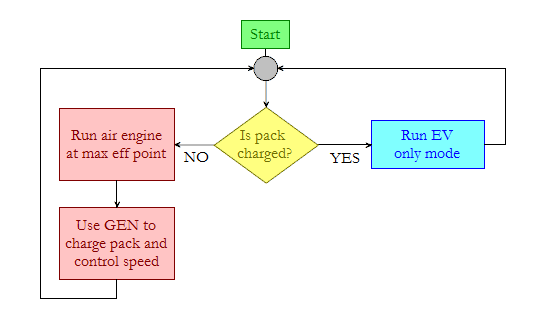Hybrid Control Strategy
We now turn our attention to controlling the benchtop hybrid system, which is a variant on the power-split hybrid used in the Toyota Prius. We will start with the simplest (and least effective) control strategy, then work our way up in efficiency and complexity.
Strategy 1
In this strategy we run the air engine only, and do not turn on the motor/generator or charge the battery pack. In fact, this strategy converts the hybrid powertrain into a conventional powertrain, and is not very efficient at all. Because the air motor speed must track the wheel speed, it will mostly run at inefficient points on its power plot. It might seem pointless to even mention this strategy, but a variant on this strategy must be adopted until the battery pack is charged.

Strategy 2
For this strategy we use the air engine only at the beginning of the drive cycle, as in Strategy 1. In addition, we also use regenerative braking during downhill parts of the cycle to charge the battery pack. When the battery pack is full, we shut off the air motor and run EV-only until the pack is depleted. Then we turn the air motor back on, and the cycle starts again. A simple flowchart of the strategy is shown in the figure above.
One interesting challenge is how to determine whether the vehicle is driving 'downhill'. If the wheel speed is observed to increase even with the throttle set at its minimum value, then the wheels are obviously being 'back driven', i.e. the vehicle is going downhill. Thus, if the wheel speed is greater than the setpoint with the throttle set at zero, then regenerative braking should be applied.

Strategy 3
The third strategy combines the best features of the previous two, and is shown in the figure above. Before the battery pack is charged, we run the air engine at its most efficient power-producing point (usually almost full throttle) and we regulate the wheel speed by applying regenerative braking. Once the pack is fully charged, we can run in EV-only mode. In this way, we only consume 'fuel' (compressed air) at the most efficient power-producing point in the air motor's power curve. This is in fact the strategy used by most students when completing the benchtop hybrid powertrain project.

